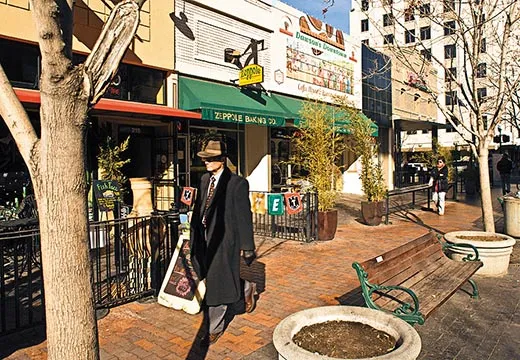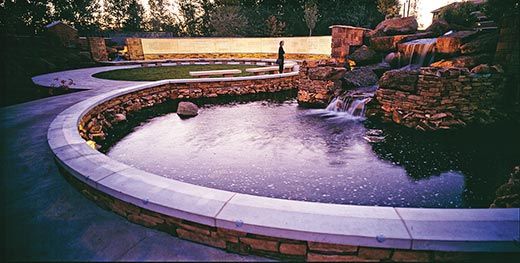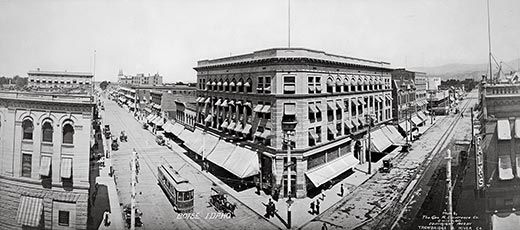Boise, Idaho: Big Skies and Colorful Characters
Idaho’s natural beauty is what makes novelist Anthony Doerr feel so much at home in Boise
/https://tf-cmsv2-smithsonianmag-media.s3.amazonaws.com/filer/Anthony-Doerr-Boise-Idaho-631.jpg)
I stand at the window, 7 in the morning, and watch snow drift across the backyard. Dawn is slow and pale. I drive my 4-year-old twin sons to preschool. The sky swirls; the roads are ribbons of slush. Fog washes between the upper stories of downtown Boise's few tall buildings.
We are passing the Hollywood Video at Broadway and Park when a doe comes skittering onto the road. The intersection is six lanes across and the Toyota in front of us flares its brake lights and 40 or 50 cars in all directions follow suit. We slide into a dangerous, slow-motion ballet. Behind the first doe come five more, radar-eared, panicky, dancing across the centerline.
A truck beside us grinds up onto the curb. A dozen cars behind us glide to a stop. No one, miraculously, appears to have crashed into anyone else.
My sons yell, "Deers, deers!" The six does reach the far side of Broadway and make several dazzling leaps into Julia Davis Park, the oldest of the string of city parks woven through the center of Boise. The deer pause for a moment, looking back, twitching their ears, exhaling vapor. Then they melt into the trees.
I breathe. The traffic realigns and creeps forward again.
Boise, contrary to the notions of Easterners I meet now and then, is not located in Indiana, Ohio or Iowa. More than 300 miles from Salt Lake City and 400 miles from Reno and Portland, Boise, Idaho, is arguably the most remote urban area in the Lower 48. The broad, sandy flood plain on which it is built forms an island in what some people still call the Sagebrush Ocean, thousands of square miles of balsamroot, sky and stillness in the Far West. Depending on the weather, Boise looks alternately silver or gold or beige or purple; after rain, it smells like menthol.
Boisé: in French it means wooded. Our nickname has long been the City of Trees, which sounds absurd to most visitors from, say, Indiana, Ohio or Iowa, whose towns' most pedestrian hardwoods dwarf all but Boise's biggest and oldest oaks. It's only when you approach the city by road, or better yet on foot, that you begin to understand how the appellations suit the place, how a thin belt of cottonwoods along a river might have looked almost supernaturally desirable to a traveler after hundreds of miles of unremitting high desert.
Imagine you're plodding through the summer of 1863, the year the city was founded. You're tired, you're thirsty, you've been passing for weeks through mountains that belong primarily to wildlife: grasshoppers the size of thumbs, anthills the size of pitchers' mounds, biblical herds of pronghorns raising dust clouds in the distance. Reefs of purple clouds gather above the horizon and the day's heat pumps off the basalt around you, and you come over a last bench to see a valley shimmering like some fabled oasis below you: a few orchards, a smattering of buildings, the silver braids of the Boise River. The 19th-century writer Mary Hallock Foote deemed Boise "the metropolis of the desert plains, the heaven of old teamsters and stage drivers crawling in at nightfall," and it's easy enough to picture. A few lights burn between the trees; a half-dozen spires of smoke rise into the dusk. The promise of rest, drink, shade—a haven, a refuge, a city of trees.
These days I can pedal past the densely built bungalows, Queen Annes and Tudor Revivals of Boise's North End into the 30 or so blocks that make up downtown Boise and eat dumplings made by Thai immigrants, buy a pair of jeans made in Guatemala and watch a Pedro Almodóvar film at an art house. Steeples rise here and there; the statehouse dome looms grandly against the backdrop of the foothills. Spend enough time in the hills, a friend who lived for several years in the Bitterroot Mountains told me, and Boise begins to feel like Paris.
But our city remains a place where we see moose tracks on the bike trails and bald eagles along the river and—once, in front of our neighbor's house—cougar prints in the snow. A dozen miles from my house I can stand in the foothills and experience the same graveyard quiet, the same desert indifference that trappers and the Shoshone and Bannock Indians knew. And beyond the foothills are lakes marked on maps only by their elevations, velvet hillsides, alpine meadows, ice caves, lava fields, roaming wolves, a last few herds of bighorn sheep. An hour from our driveway wild kokanee salmon still spawn in the creeks and migratory bull trout still grow to 20 pounds.
This is not to suggest that Boise is a citadel encircled by wilderness. Our exurbia continues to distend, and with this comes cheat grass, air pollution and gridlock. The grizzlies are gone, the chinook salmon have to be trucked past dams, and every year the deer and elk find more winter rangeland transformed into subdivisions. Like most Americans, we fertilize our lawns, erect our vinyl fences and chlorinate our swimming pools. We forget, most of the time, about our wilder neighbors, the creatures that live out on the cloud-swept, corrugated watershed beyond our cul-de-sacs.
But every few days a half-dozen mule deer scramble across a downtown intersection, or a fox steals a garden glove from the backyard, or a pair of sandhill cranes land in the marsh behind a steakhouse and remind us where we live. In those moments the paradox that is Boise strikes deeply and keenly: it is a place both rural and metropolitan, civilized and feral. It's a town full of settlers and wanderers, conservationists and conservatives, hippies and hunters, folks who value both snowmobiles and tiramisu, who clean their shotguns one evening and donate to the Shakespeare Festival the next.
I have a friend who sells commercial roofing and is so adept at fly-fishing he can stand 50 feet up on a cutbank and identify the shapes of brown trout holding among weeds on the bottom of a surly river. Another friend trades commodities all day but wanders off alone into the Pioneer Mountains every October with a bow and a bottle of elk urine to use as an attractant. And I know a real estate developer who's so skilled on telemark skis you can hardly believe he isn't an Olympic athlete; he'll slip down the backside of a ridge and a curtain of powder will rise up over his head, and beneath the snow his entire body will have transformed itself into a fluid, white submarine flowing between the trees.
Boise is a place with a long human history—the Bannocks, the Shoshones and older tribes, too. Not far from here, in Buhl, Idaho, the 11,000-year-old skeleton of a woman turned up in a quarry, some of the oldest human remains that have been found in North America. There are pictographs in our hills and bones in our caves. Ghosts are everywhere, wandering beneath the brick buildings of Boise's Basque Block, dozing in the ruts along the Oregon Trail, prospecting for gold in the gulches northeast of town. In autumn, you can almost feel the breeze moving them about, dislodging them from the corners of the gardens, stirring them from beneath the leaves. Here, an enterprising engineer devised the valley's grand irrigation canal; there, a Shoshone boy traded camass roots. And before humans, there were short-faced bears larger than grizzlies, giant camels and horses like zebras. Ten-ton imperial mammoths used to wander our hills.
I drop off my sons at school and help them hang up their coats. Then I walk through the park. To my right, across the river, rise the brick-and-glass buildings of Boise State University. To my left lie the art museum, the rose garden and the Boise Zoo. Beyond the zoo, patches of blue sky wink above the tops of downtown buildings. Snow sifts across the sidewalks. Seven crows land in a leafless hawthorn. Five take off again.
In this very spot last August it was 105 degrees. My sons and I stepped out of our air-conditioned car and the desert heat dropped on us like a predator—a sneak-up-from-behind mugger. Our eyes teared up and our breath disappeared and the kids covered their eyes with their forearms as if they'd been stung. Now maybe 100 mallards are gathered on the ice beneath the footbridge, squirming and ruffling and chirping at one another.
I live here because I can ride my bike to friends' houses just like I did when I was 10 years old, because I can float on a mostly clean river through the center of town and look up and see people working on their computers in office buildings. I live here because I can eat a $5 lunch at Zeppole, as I did for about 400 afternoons straight while I was writing my first novel, and because every time I think I'm running quickly along the trails in the foothills, someone is always there to blow past me and make me feel like I'm not in such good shape after all. I live here because I can get in a car and head in any direction and within an hour find myself in something pretty close to wilderness, and because of the archipelagoes of clouds that float over the hills in late summer, each one a towering, big-shouldered miracle.
Boise is still so young and new—changing almost every day—and I don't think it's overstatement to suggest that our town represents everything that remains great about America: potential, youth, natural beauty, quality of life. Some 100 parks, 14 museums, playgrounds everywhere you turn: our skies are huge; our houses affordable. Hikers can still drink from a secret spring in the hills; paddlers can still go kayaking in the morning and meet with their accountants by noon. When we visit friends who live elsewhere, they ask, "Boise? Really? Why do you live there?" But when friends visit us, they say, "Oh, wow, now I see."
What all of us who live here share is the landscape, the light, the seasons, the pair of peregrine falcons that nest downtown, and the rainbow trout that swim in our river. We share the feeling we get when the unexpected skitters across the road and cracks open the insulation we've packed around our mornings—when we remember for a moment where we live.
This morning in Julia Davis Park the sky is breaking apart everywhere. The foothills shine and billow. I look through the leafless branches of the trees and see the deer, once more, dancing across the road. I see the mystery and vastness of time. I think: this is the pure world. This is the long view. This is what lasts.
Anthony Doerr is the author of The Shell Collector and About Grace.
Planning Your Next Trip?
Explore great travel deals
Smithsonian magazine participates in affiliate link advertising programs. If you purchase an item through these links, we receive a commission.




